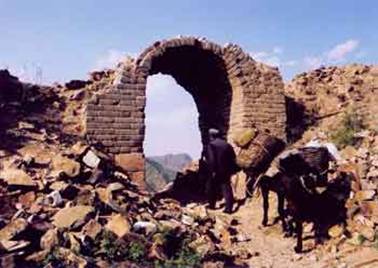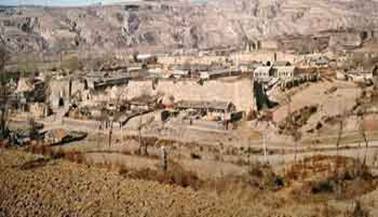In recent history China has seen three great waves of migration, ‘moving through the Western passage’, ‘the dash Eastwards’ and ‘setting sail on the Southern seas. These shifts in population have witnessed a dramatic change in character of the Chinese people as they turned their backs on their home towns and forged a new life in a strange land.

The ‘movement through the Western passage’ can be divided into three stages: war, hardship and finally life changing.
The ‘Western passage’ is a section of the Great Wall that runs along the northern boarder with Shanxi and Inner Mongolia (near the city of Datong – due west of Beijing). The earliest recorded exact site of the passage is at Youyu County, which is in actual fact one of the main passes in the Great Wall, known to everyone as Tiger Killing Pass.

Ruins of the Great Wall
Since the mid-Ming dynasty owing to Shanxi’s poor faming conditions and large population, the region has constantly struggled to maintain stability, with traditional faming methods having to be supported in other ways.
It was through a very developed business economy that Shanxi was able to make a living by propping up the regions of the central plains as well as acting as a conduit between central China and the north western regions such as Inner Mongolia.
Ever since peace was made with many of the great Mongol Khans under the Ming, the people of Shanxi have had more and more to do with the Steppe and indeed many even made the often risky and dangerous journey out westward beyond the Great Wall to earn a living. It is for this reason that the journey west was to many the greatest risk they would ever take in their lives.

With its peak in the 17th century, this mass exodus of the poorest members of Shanxi society nevertheless lasted over 300 years, from the mid Ming right through to the late Qing (19th century).
Much of present day Inner Mongolia bares the marks of this movement of people, many of whom made the journey themselves in their youth or are direct descendants of migrants to the area.
Donghe District lies to the south of Mount Da Qing and to the north of the Yellow River. At its peak as the main grain, skins and medicine trading centre of Inner Mongolia to the west of Baotou, Donghe would see nearly 2kms of over 2000 vessels sailing its waterways.

A snap shot of Donghe District, Baotou City
Indeed, the ‘Western passage’ has an inescapable link with the Yellow River, in so much as the people working there built over 100 docks, the biggest of which has now been turned into southern Baotou’s very own Nanhai Park – a monument built in 1985 to the people who migrated to the banks of the Yellow River over the centuries.
For many people, the movement west was a matter of ‘forging your heart and guts out of iron and never looking back’, in other words it is the story of many hundreds and thousands of men and women who made the difficult path into the unknown to escape starvation on the central plains of China, only to find a life of hard toil in an alien land. For those who got lucky their reward was to live to see their hard work prosper, for the less fortunate, China’s backyard proved just as wild as any other West.
***
China Media - The Dirt on China’s Wild West
City Guide – Hohhot: History | Attractions | Hotels | Entertainment
City Guide – Taiyuan: Overview | Shopping | Attractions
City Guide – Jinan: Overview | Parks & Museums | Scenic Spots
Warning:The use of any news and articles published on eChinacities.com without written permission from eChinacities.com constitutes copyright infringement, and legal action can be taken.
All comments are subject to moderation by eChinacities.com staff. Because we wish to encourage healthy and productive dialogue we ask that all comments remain polite, free of profanity or name calling, and relevant to the original post and subsequent discussion. Comments will not be deleted because of the viewpoints they express, only if the mode of expression itself is inappropriate.
Please login to add a comment. Click here to login immediately.